Trail Signs in the Swiss Alps
A wide network of well signed trails
Switzerland is a paradise for hikers from both home and abroad. There are over 60,000km of hiking trails for everyone from the novice hiker (or those with young children) to the experienced, looking for a challenging hike. The trails are all easy to choose and navigate, due to the uniform system of signposts and markers that the Swiss use to mark and differentiate trails.
Solid yellow signs and markers (usually diamond shaped) indicate a pedestrian or walking trail, signs with red and white stripes at the tip or red and white markers painted on trees and stones indicate a more challenging hiking or mountain trail and those with blue and white stripes indicate an Alpine route that is more technical and requires additional safety equipment
Signs everywhere
You’ll find well maintained trails and their signs in the center of cities, and towns as well as in remote alpine settings. About 36% of the hiking trails are located below 1000 meters. Most of the hiking trails, about 55%, are located between 1000 and 2000 meters and the remainder at elevations above 2000 meters.
The multitude of signs on these trails tell you not only the type/difficulty of route as indicated above, but also the destination and the time estimated to get there. Signs will also indicate if there are restaurants of public transport at the destination.
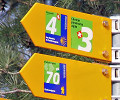
If the trail is one of the official national, regional or local routes, the signs will often show the route number as well. These route numbers can be found on Wanderland.ch.
Types of Trails and Signs
Trails and the corresponding signs and markers are divided into four types:
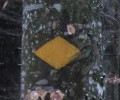 Pedestrian trails, which are suitable for any walker are marked by standard yellow signs. These are usually a relatively smooth dirt path.
Pedestrian trails, which are suitable for any walker are marked by standard yellow signs. These are usually a relatively smooth dirt path.
This type accounts for nearly two-thirds of all the trails.
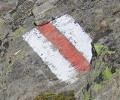 Hiking trails, marked by a red and white bars indicate more challenging mountain routes. These are often narrow dirt paths, with rocks and obstacles.
Hiking trails, marked by a red and white bars indicate more challenging mountain routes. These are often narrow dirt paths, with rocks and obstacles.
This type comprises nearly a third of all trails.
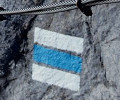 Technical alpine routes, marked by blue and white bars, which require special gear such as ropes, and helmets as they will often involve climbing over obstacles.
Technical alpine routes, marked by blue and white bars, which require special gear such as ropes, and helmets as they will often involve climbing over obstacles.
This type of trail accounts for just 1% all of the trails
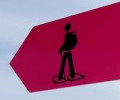 During the winter season, many of the hiking trails are closed and separate winter walking trails are opened, marked with magenta signs. These are often only walkable using snow shoes.
During the winter season, many of the hiking trails are closed and separate winter walking trails are opened, marked with magenta signs. These are often only walkable using snow shoes.
The Swiss Hiking Association
The signs are crafted by the Swiss Hiking Association (Schweizer Wanderwege/Suiss Rando), which in 1934 planned and installed the initial signs at intersections along well known Swiss trails. All of the trail signs and markers are installed and looked after by volunteer workers of the cantonal hiking associations or municipalities, through a public-private partnership. Each year, all of the signs and trails are inspected and maintenance undertaken as necessary.
18,991 total views, 4 views today
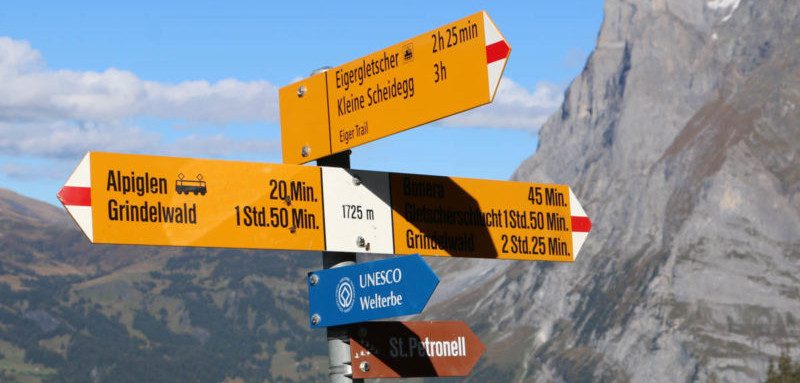
One comment